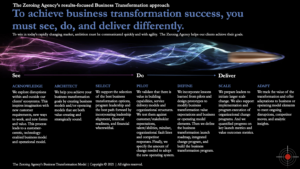The Point: In many industries, business transformation or change management programs often fail. We know that business transformation is not for the weak of heart. We’ve seen change leadership in a company not be united and/or committed before, during, and especially after transformations. So are there portions of the business that leaders need to pay attention to? Seriously, not only the specific initiatives but also the changes that leaders are making as to how the business actually works? In this post we’ll explore the ‘how?’ of business transformation in search of a performance infrastructure that is essential for a successful transformation. Once discovered, it will allow you to achieve rapid, dramatic and long-lasting business improvement. Creating an “infrastructure of performance” can help ensure success… Enjoy!
Attend Webinars & Workshops – View our upcoming Webinars & Workshops
The Case for Business Transformation – Why?
Today’s business environment is full of disruptive forces. Even in less volatile industries, disruptive forces abound. These disruptions include technological innovation, regulatory changes and pressure from activist investors. Many technology companies — both software and hardware — are undertaking such business transformations. Sometimes they do so in response to external pressure, but other times it is to stay ahead. These companies, regardless of their motivations, are trying to introduce new ways of working for large numbers of employees with the aim of achieving a step-change in business results.
The sad reality is, however, that the majority of these organizations are not able to change. Business transformations more than often fail. Research has shown that 70% of large-scale, complex change management programs fail to achieve their goals. Common pitfalls are a lack or inadequate management support, low employee engagement, poor cross-functional collaboration and a lack in accountability. A major change in mindsets and behavior is required to sustain a business transformation’s success. This is something that very few leaders are able to do.
As practitioners in Business Transformation, The Zeroing Agency — a Tip of the Spear Venture — focuses on supporting such turnarounds and transformations. When it comes to Business transformation, we’ve seen it across all industries, and we know that the hardest part of improving performance isn’t deciding what to do but rather — how to do it. This article will discuss an important component of the ‘how‘ of business transformation: the creation of an “infrastructure for performance” which is made up of people, processes and tools that allow successful execution and sustainable results.
Looking to Transform Your Business?
Download Your 37 page | 128 question Business Transformation Self-Assessment Workbook!
Performance Improvement Requires a Holistic Approach
Companies in financial trouble tend to be more focused on cost reduction and immediate solutions. Many consumer-focused businesses are able to offer stable and healthy product categories. These companies don’t see transformation as a struggle for survival. It’s about reaching the full potential of the company (going from good-to-great) or responding to external challenges or opportunities, such as learning new ways to win or moving away from a historical money-maker.
We have found that no matter what the circumstance, true transformation occurs when the leadership team accepts the idea that there is a holistic approach to changing the way the business operates. This includes addressing all factors that add value to the organization, such as top line and bottom line. This is not an easy task. Ordinary transformation approaches often produce suboptimal results.
To achieve extraordinary results, we believe a comprehensive, highly disciplined methodology–encompassing both the “what” and the “how”–is needed (exhibit). The “what” refers to the smooth flow of specific ideas and initiatives throughout three phases: planning, independent diligence, and implementation. For the experienced executive, these phases will be familiar. We find that executives are more focused on the individual initiatives than how the company must change. This is a problem that many leaders feel. They express concern about sustainability and execution risk, and know that initiatives won’t stick unless they fundamentally change the way the business operates. How can an organization transform its operating model? The “how” is broken down into two parts: performance infrastructure and change management. Many organizations find change management challenging. We will discuss this in detail in a future article. This article will focus on the performance infrastructure. It is essential for effective alignment, communication and coordination at executive level during a transformation.
Making Change Happen at Speed
Performance infrastructure is made up of people, processes, and tools that all work together to deliver superior execution and value. It is the heart of a transformation effort, and plays an important role in its success.
The People: A Governance Structure Lead by a Chief Revenue Officer?
To oversee the execution of each “workstream” (or area of activity), ensure decisions are made quickly, and keep the transformation on course, companies must create a governance structure–specifically, a transformation office (TO) comprising a few respected executives supported by analysts from the finance and HR functions. The Chief Revenue Officer (CRO) should lead the TO and be part of the company’s executive committee. The CEO should be regularly updated by the TO on progress, and highlight issues and possible solutions.
You might wonder, “Is a CRO in charge of business transformation really necessary — or appropriate?” The CEO should lead the transformation. We are unambiguous in our answer. The CEO should be the leader of the company. A full-time, experienced CRO should oversee the transformation. Why?
A CRO with extensive experience in leading sales in companies experiencing business transformation is the ideal candidate. The CRO should have a vision of what is possible. This includes a view of the company’s performance and current capabilities, as well as a realistic plan to encourage different groups to work together.
This is a demanding job, especially in comparison with the already monumental duties assigned typically to a CRO. However, the CRO must radiate confidence and gravitas from the beginning. This will ensure that the organization is motivated and inspired, no matter what the circumstances. The CRO should not be a stern, egotistical dictator. Instead, they must have the ability to see and judge how people are doing so that they can reach their full potential. The CRO should also be able to take deep dives into complicated issues important to the company.
The CRO should extend the CEO’s reach and have the authority and mandate to manage all levers and influence decisions regarding personnel, investments and operations. The CRO can be an important part of “getting people on the bus,” making key decisions regarding the addition or removal of managers.
Many companies lack the ability to find someone with these qualifications, let alone one who can step in and fill the position. Therefore, the CRO often comes from the outside. Although company leaders might be concerned about the outsider, the ability of an outsider to see the business and make decisions without being restricted by internal politics is one of the most important success factors for a CRO.
The Process: An Unstoppable Cadence of Delivery
Ineffective business transformation is possible if it takes too long. A weekly schedule of transformation meetings is essential to creating a performance infrastructure. Most turnarounds are managed by a project management office that meets once a week to discuss all workstreams. We recommend a 60-to-90-minute weekly meeting for each workstream. In addition to a weekly TO meeting of two hours, we recommend a cadence for weekly transformation meetings. This cadence works because it is relentless and aggressive. It enforces “closed loop” accountability, accelerates implementation, and prevents “pocket vetoes,” other delay tactics, and slippage.
Meetings, and in particular the question-and answer exchanges between CRO and line leaders, are essential for holding people accountable. This is not a consensus-driven approach. The CRO should be open to confrontation when managers fail to meet their promises. Meetings should be transparent and honest. This allows the organization to assess its current situation and identify the best solutions. Transparency is essential to help everyone understand the company’s priorities and decision-making process.
These weekly meetings provide a platform for discussing and debating difficult tradeoffs between revenue generation and cost reduction, as well as for refining individual plans for each initiative. The TO is able to quickly make cross-functional decisions and help prioritize and evaluate competing priorities. The weekly meetings are a valuable tool for developing new talent, and identifying individuals who can be the most beneficial to an initiative. The weekly meetings were used by the TO to identify highly-motivated and high-performing individuals to help develop and build the mobile app.
Although the weekly cadence is an important building block in the transformation process, it’s not sufficient on its own. To instill an execution-focused mindset into daily decision-making, monthly value analysis to quantify the bottom-line impact and an annual “refresh”, which plugs into budget cycles to rekindle idea generation and foster continuous improvement, it should be supplemented with daily performance management.
The Tools: Transparent Reporting and Accurate Tracking Systems
The tools and systems that are used to monitor business transformation performance make up the third component of the performance infrastructure. These might include organizational-health assessments, benchmarks, value-capture models, and visual management and planning aids. Advanced initiative-tracking tools, such as those that can be sorted according to owner, department, delivery status and other criteria, allow users to quickly see the progress of all initiatives. These tools should be easy to use, allowing users to identify delays and trends, track impact, and create rich, yet simple reports. These tools should be accessible to all involved in the transformation.
Our experience shows that the best tools for leaders to monitor the impact of initiatives have the greatest success rate in business transformations. Too many executives simply launch initiatives and hope that the money will eventually show up in their company’s bank accounts. Initiative owners can use sophisticated tracking tools to tie each initiative’s impact to a profit and loss line item. Executives can use this level of detail to make sure that each initiative has a positive impact on business results — It also builds in additional layers of accountability towards achieving the ultimate business transformation goals.
SUMMARY
Business Transformation is not for the weak of heart. Before embarking on a change management program, change leadership in a company must be united and committed. Once they have achieved this, they need to pay attention to not only the specific initiatives but also the changes that they are making to how the business actually works. A performance infrastructure is essential for a successful transformation. It will allow you to achieve rapid, dramatic and long-lasting business improvement.
Sam Palazzolo





